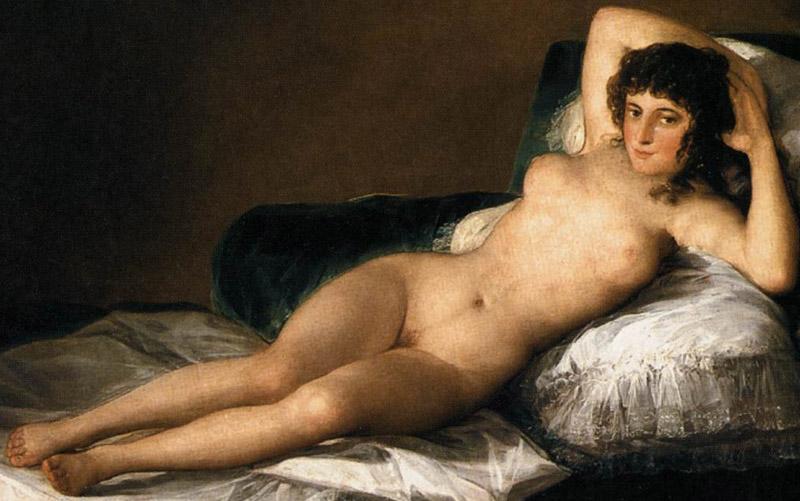What does it mean? Hair can do a lot of symbolic work. In science fiction movies, alien creatures are the hairless ones. Hairlessness marks the post-human. Yet it is also marks the divide between human and animal. The hairy ones are closer to nature, to animality. Just think of Jacob and Esau. Esau, a hunter beloved by his father, has hairy skin; Jacob, a mother’s boy of the tents who cheats his brother out of his birthright, does not. Body hair historically has been a mark of manliness. Femininity was located in the hair on a woman’s head, not on her body. For men, it was the reverse: Real men had chest-hair. No wonder a lot of girls find the first appearance of pubic hair unnerving, ugly, even nauseating. A lot of women who wax say they “hate” that hair.
In the sweep of Western art history of the nude, female pubic hair could not be shown. Bosch, Titian, Michelangelo painted hairless vaginas. Even Manet, when he painted the famous prostitute, Olympia, in 1863, couldn’t bring himself to show it. Pubic hair marked a woman’s sexual desire, her erotic passion: to show it was beyond all bounds of modesty. When Francisco de Goya painted La Maja Desnuda around 1800 for the Spanish prime minister, it was a breakthrough: an ordinary naked woman—neither goddess nor allegory—with pubic hair fully exposed. Goya’s model is looking at you looking at her. The Prime Minister kept it hidden in a private room, shown only to those he trusted. Goya was later called before the Spanish Inquisition for this work.
Pubic hair signals our capacity to make life; the way we know we are no longer girls and boys. It is an evolutionary relic, its function to conduct plumes of sex pheromones into the atmosphere that signal a female’s readiness to reproduce and critical information about male and female genetic qualities. Ovulating strippers get twice the tips as those who are having their periods. Life-making and mate selection are a smelling affair. Shearing genital hair cleans up the zone. It displays free-standing sex organs, separated from reproductive sense, staging a physical encounter between erect boys and open girls in a magical garden where one can live forever.
A hairless vagina is symbolically unhinged not only from reproductive possibility, but from spiritual union, from knowing. The vagina is our template for the ultimate sacred space, a holy of holies where no one else can enter: unseeable, unsayable, the template of pleasure by which the pains of this worldly existence are to be measured. In Hebrew, to engage in sexual intercourse literally means “to know.” This is not just a euphemism. The connection between erotic desire and knowledge is lodged both in our origin story in the Garden of Eden, and written into the word philosophy—philo, loving, sophia, knowledge or wisdom—a loving of knowledge. That loving is grounded in erotics. A woman’s pubic hair veils the passage, marking the sacrality of that space of knowing. Shaving it away stamps it as a mere organ, a passage where anyone can linger pleasantly, where something is done, not somebody known. Pubelessness is an affirmation of the pure body and a negation of corporeal soul, separating the center of one’s flesh from birth and from knowing.
American women are, in fact, striking a pornographic pose, one that first appeared in the hard-core porn films that were increasingly shaping the sexual imagination of legions of young men. The eye of the hard-core porn camera hovers over female body parts; it’s a visual excess of physical acts with a minimum of sentiment. It is not a love story. Porn displays pubeless bodies to emphasize the organs—the female genital slit (and the erect male shaft)—and thereby defines the standard of erotic desirability. As nether hair disappeared on screen guys increasingly wanted sex with girls who looked like the porn stars they’d fantasized about. They asked and women emulated.
A porn body is not a body that loves, a body to which love adheres. It is a uniform for male fantasy and that fantasy has a history. The timing of bushless porn tells a shriveling tale. Pubic hair appeared for the first time in Penthouse in 1970. In 1974, Hustler published the first “pink shots” of labial flesh. But the porn starlets only began shaving it off in the 1980’s. Until then, they cavorted on screen with full bushes. You can see the same—but slower—progression with the more demur Playboy centerfolds.

Page 2 of 4 | Previous page | Next page
